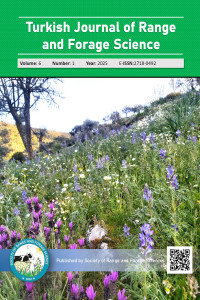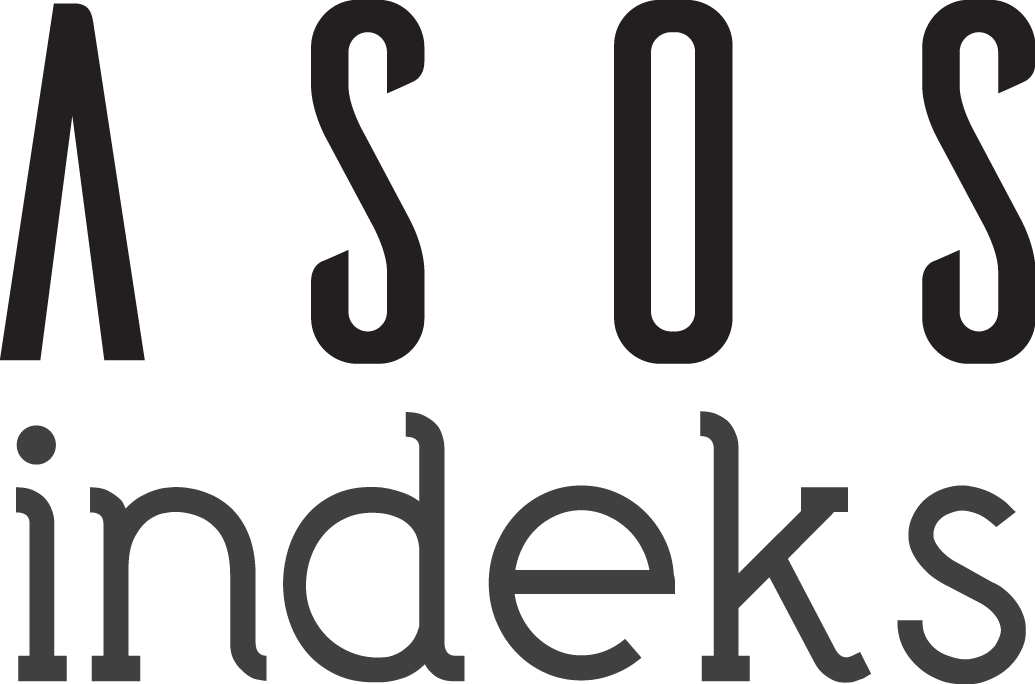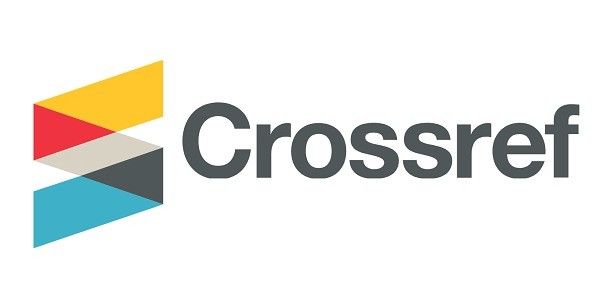Abstract
Project Number
The research was conducted with the authors' own means.
References
- Acar, Z., & Bostan, M. (2016). Değişik doğal katkı maddelerinin yonca silajının kalitesine etkilerinin belirlenmesi. Anadolu Tarım Bilimleri Dergisi, 31(3), 433-440.
- Ahsan, U. (2023). Effect of single or combined homo- and heterofermentative silage additives on the quality, nutritive val¬ue, and in vitro digestibility of ensiled wheat harvested at early dough stage of maturity.
- Mehmet Akif Ersoy University Jour¬nal of Health Sciences Institute, 11(2), 267-274.
- Akbay, F., Günaydın, T., Arıkan, S. & Kızılşimşek, M. (2023) Performance of new lactic acid bacteria strains as inoculants on the microorganism composition during fermentation of alfalfa silage containing different dry matter content. Black Sea Journal of Agriculture, 6(4) 402-410.
- AOAC (2000). Official methods of analysis of AOAC International. Association of Official Analytical Chemist, Washington DC.
- Aydın, S. S., Denek, N., Avcı, M., Kırar, N., & Top, Ş. (2023). The effect of fermented natural lactic acid bacteria liquid and water-soluble carbohydrate admixture on alfalfa (Medicago sativa L.) silage fermentation quality, in vitro digestibility and methane production. Veterinary Journal of Mehmet Akif Ersoy University, 8(3), 172-178.
- Besharati, M., Karimi, M., Taghizadeh, A., Nemati, Z., & Kaygısız, A. (2020). Improve quality of alfalfa silage ensiled with orange pulp and bacterial additive. Kahramanmaraş Sütçü İmam Üniversitesi Tarım ve Doğa Dergisi, 23(6), 1669-1677.
- Çotuk, G. M., & Önenç, S. S. (2017). Yonca silajına kepek ve puding ilavesinin silaj fermantasyonu, aerobik stabilite ve in vitro sindirilebilirlik üzerine etkileri. Hayvansal Üretim, 58(1), 13-19.
- DLG (1987). Bewertung von Grünfutter, Silage und Heu, Merkblatt, No:224, DLGVerlag, Deutschland. In:
- Karadeniz, E., & Saruhan, V. (2021). Mardin ekolojik koşullarında farklı ekim zamanlarında yetiştirilen ikinci ürün silajlık mısır (Zea mays L.) çeşitlerinin silaj özelliklerinin araştırılması. ISPEC Journal of Agricultural Sciences, 5(2), 275-289
- Dumlu Gül, Z., Tan, M., Fayetörbay Kaynar, D., & Kharazmi, K. (2015). Effects of some additives, harvest stage and wilting on quality characteristics of alfalfa silage. Atatürk Üniversitesi Ziraat Fakültesi Dergisi, 46(2), 113-118.
- Horrocks R. D., & Vallentine J. F. (1999) Harvested forages. Academic Press, London, UK. In: Ahsan, U. (2023). Effect of single or combined homo-and heterofermentative silage additives on the quality, nutritive value, and in vitro digestibility of ensiled wheat harvested at early dough stage of maturity. Mehmet Akif Ersoy University Journal of Health Sciences Institute, 11(2), 267-274.
- Kılıç, Ü., & Abdiwali, M. A. (2016). Alternatif kaba yem kaynağı olarak şarapçılık endüstrisi üzüm atıklarının in vitro gerçek sindirilebilirlikleri ve nispi yem değerlerinin belirlenmesi. Kafkas Universitesi Veteriner Fakultesi Dergisi, 22(10.9775).
- Li, P., Ji, S., Hou, C., Tang, H., Wang, Q., & Shen, Y. (2016). Effects of chemical additives on the fermentation quality and N distribution of alfalfa silage in south of China. Animal Science Journal, 87(12), 1472-1479.
- Mariotti, M., Fratini, F., Cerri, D., Andreuccetti, V., Giglio, R., Angeletti, F. G., & Turchi, B. (2020). Use of fresh scotta whey as an additive for alfalfa silage. Agronomy, 10(3), 365.
- Moselhy, M. A., Borba, J. P., & Borba, A. E. (2015). Improving the nutritive value, in vitro digestibility and aerobic stability of Hedychium gardnerianum silage through application of additives at ensiling time. Animal Feed Science and Technology, 206, 8-18.
- NRC (2001). Nutrient requirements of dairy cattle (7th rev. ed.). National Academies Press, Washington, D.C. Rinne, M., Stefański, T., Franco, M., Jalava, T., & Kuoppala, K. (2024). Forage type and additive effects on fermentation quality and biorefinery performance of silages. Grass and Forage Science, 79, 170–178.
- Rohweder, D. A., Barnes, R. F., & Jorgensen, N. (1978). Proposed hay grading standards based on laboratory analyses for evaluating quality. Journal of Animal Science, 47(3), 747-759.
- SAS (1998). INC SAS/STAT users’ guide (Version 6, 4th ed.). SAS Institute, Cary, NC.
- Tatli Seven, T., Seven, I., Iflazoglu Mutlu, S., & Yildirim, E. N. (2021). Silage Additives Usage in Improving Fermentation Quality of Alfalfa Silage: A Review. Animal and Veterinary Sciences, 9(6), 175-180.
- Tian, J., Na, R., Yu, Z., Liu, Z., Liu, Z., & Yu, Y. (2018). Inoculant effects on the fermentation quality, chemical composition and saponin content of lucerne silage in a mixture with wheat bran or corn husk. Animal Production Science, 58(12), 2249-2257.
- Tremblay, G. F., Morin, C., Bélanger, G., Bertrand, A., Castonguay, Y., Berthiaume, R., & Allard, G. (2014). Silage fermentation of pm‐and am‐cut alfalfa wilted in wide and narrow swaths. Crop Science, 54(1), 439-452.
- Van Soest, P. J. (1994). Nutritional ecology of the ruminant (2nd ed.). Cornell University Press, Ithaca, NY
- Van Soest, P.J., Robertson, J.B. & Lewis, B.A. (1991). Methods for dietary fiber, neutral detergent, and nonstarch polysaccharides in relation to animal nutrition. Journal of Dairy Science, 74, 3583-3597.
- Wang, Y., Wei, M., Yang, F., Zheng, H., Gao, J., Peng, W., ... & Zheng, Y. (2024). Effects of different additives on the chemical composition, fermentation quality, bacterial community and gene function prediction of caragana korshinskii kom. silage. Agronomy, 14(10).
- Yang, F., Wang, Y., Zhao, S., Feng, C., & Fan, X. (2022). Dynamics of the fermentation products, residual non-structural carbohydrates, and bacterial communities of wilted and non-wilted alfalfa silage with and without lactobacillus plantarum inoculation. Frontiers in Microbiology, 12.
- Zi, X., Liu, Y., Chen, T., Li, M., Zhou, H., & Tang, J. (2022). Effects of sucrose, glucose and molasses on fermentation quality and bacterial community of stylo silage. Fermentation, 8(5), 191.
Abstract
The study was conducted to determine the effects of different withering times and additives on some physical and chemical parameters and the feed value of alfalfa (Medicago sativa) silage. In the study, Bilensoy alfalfa variety, 3 different withering times (0, 12 and 24 hours) and 6 different additives (control, 4% barley, 4% wheat, 4% corn, 4% bran, and 2% sucrose) were added, and 18 subjects were examined. Silages were formed in the laboratory using vacuum bags (25 × 35 cm in size, 110 micron thickness) and vacuum machines, and the packages were kept at room temperature for 2 months for silage maturation. The DLG scoring method was used to determine the physical quality of mature silages. For chemical quality and feed value, dry matter, pH, crude protein, crude ash, ADF, and NDF values of the silage samples were determined; the Fileg score, total digestible nutrients, dry matter consumption, digestible dry matter, net energy lactation, and relative feed value were calculated.
When the research findings were evaluated, the prolonged withering period decreased the crude protein rate determined in alfalfa silage, while DLG classification, pH, Fleg score, dry matter, crude ash, ADF, and NDF rates increased significantly. While the effect of additives added to alfalfa silage on DLG classification was insignificant, it was found to be statistically significant in the other properties examined. It was determined that the additives decreased DLG classification, pH, crude protein, NDF, and ADF ratios, increased Fleg score and crude ash ratio, and significantly improved feed value parameters compared to the control group. As a result, in terms of optimum feed value and alfalfa silage quality, 24-hour withering and 4% maize addition can be recommended compared to the other treatments compared.
Ethical Statement
No live animals were used in the study.
Supporting Institution
The facilities of Isparta University of Applied Sciences, Faculty of Agriculture were utilized in the research.
Project Number
The research was conducted with the authors' own means.
Thanks
N/A
References
- Acar, Z., & Bostan, M. (2016). Değişik doğal katkı maddelerinin yonca silajının kalitesine etkilerinin belirlenmesi. Anadolu Tarım Bilimleri Dergisi, 31(3), 433-440.
- Ahsan, U. (2023). Effect of single or combined homo- and heterofermentative silage additives on the quality, nutritive val¬ue, and in vitro digestibility of ensiled wheat harvested at early dough stage of maturity.
- Mehmet Akif Ersoy University Jour¬nal of Health Sciences Institute, 11(2), 267-274.
- Akbay, F., Günaydın, T., Arıkan, S. & Kızılşimşek, M. (2023) Performance of new lactic acid bacteria strains as inoculants on the microorganism composition during fermentation of alfalfa silage containing different dry matter content. Black Sea Journal of Agriculture, 6(4) 402-410.
- AOAC (2000). Official methods of analysis of AOAC International. Association of Official Analytical Chemist, Washington DC.
- Aydın, S. S., Denek, N., Avcı, M., Kırar, N., & Top, Ş. (2023). The effect of fermented natural lactic acid bacteria liquid and water-soluble carbohydrate admixture on alfalfa (Medicago sativa L.) silage fermentation quality, in vitro digestibility and methane production. Veterinary Journal of Mehmet Akif Ersoy University, 8(3), 172-178.
- Besharati, M., Karimi, M., Taghizadeh, A., Nemati, Z., & Kaygısız, A. (2020). Improve quality of alfalfa silage ensiled with orange pulp and bacterial additive. Kahramanmaraş Sütçü İmam Üniversitesi Tarım ve Doğa Dergisi, 23(6), 1669-1677.
- Çotuk, G. M., & Önenç, S. S. (2017). Yonca silajına kepek ve puding ilavesinin silaj fermantasyonu, aerobik stabilite ve in vitro sindirilebilirlik üzerine etkileri. Hayvansal Üretim, 58(1), 13-19.
- DLG (1987). Bewertung von Grünfutter, Silage und Heu, Merkblatt, No:224, DLGVerlag, Deutschland. In:
- Karadeniz, E., & Saruhan, V. (2021). Mardin ekolojik koşullarında farklı ekim zamanlarında yetiştirilen ikinci ürün silajlık mısır (Zea mays L.) çeşitlerinin silaj özelliklerinin araştırılması. ISPEC Journal of Agricultural Sciences, 5(2), 275-289
- Dumlu Gül, Z., Tan, M., Fayetörbay Kaynar, D., & Kharazmi, K. (2015). Effects of some additives, harvest stage and wilting on quality characteristics of alfalfa silage. Atatürk Üniversitesi Ziraat Fakültesi Dergisi, 46(2), 113-118.
- Horrocks R. D., & Vallentine J. F. (1999) Harvested forages. Academic Press, London, UK. In: Ahsan, U. (2023). Effect of single or combined homo-and heterofermentative silage additives on the quality, nutritive value, and in vitro digestibility of ensiled wheat harvested at early dough stage of maturity. Mehmet Akif Ersoy University Journal of Health Sciences Institute, 11(2), 267-274.
- Kılıç, Ü., & Abdiwali, M. A. (2016). Alternatif kaba yem kaynağı olarak şarapçılık endüstrisi üzüm atıklarının in vitro gerçek sindirilebilirlikleri ve nispi yem değerlerinin belirlenmesi. Kafkas Universitesi Veteriner Fakultesi Dergisi, 22(10.9775).
- Li, P., Ji, S., Hou, C., Tang, H., Wang, Q., & Shen, Y. (2016). Effects of chemical additives on the fermentation quality and N distribution of alfalfa silage in south of China. Animal Science Journal, 87(12), 1472-1479.
- Mariotti, M., Fratini, F., Cerri, D., Andreuccetti, V., Giglio, R., Angeletti, F. G., & Turchi, B. (2020). Use of fresh scotta whey as an additive for alfalfa silage. Agronomy, 10(3), 365.
- Moselhy, M. A., Borba, J. P., & Borba, A. E. (2015). Improving the nutritive value, in vitro digestibility and aerobic stability of Hedychium gardnerianum silage through application of additives at ensiling time. Animal Feed Science and Technology, 206, 8-18.
- NRC (2001). Nutrient requirements of dairy cattle (7th rev. ed.). National Academies Press, Washington, D.C. Rinne, M., Stefański, T., Franco, M., Jalava, T., & Kuoppala, K. (2024). Forage type and additive effects on fermentation quality and biorefinery performance of silages. Grass and Forage Science, 79, 170–178.
- Rohweder, D. A., Barnes, R. F., & Jorgensen, N. (1978). Proposed hay grading standards based on laboratory analyses for evaluating quality. Journal of Animal Science, 47(3), 747-759.
- SAS (1998). INC SAS/STAT users’ guide (Version 6, 4th ed.). SAS Institute, Cary, NC.
- Tatli Seven, T., Seven, I., Iflazoglu Mutlu, S., & Yildirim, E. N. (2021). Silage Additives Usage in Improving Fermentation Quality of Alfalfa Silage: A Review. Animal and Veterinary Sciences, 9(6), 175-180.
- Tian, J., Na, R., Yu, Z., Liu, Z., Liu, Z., & Yu, Y. (2018). Inoculant effects on the fermentation quality, chemical composition and saponin content of lucerne silage in a mixture with wheat bran or corn husk. Animal Production Science, 58(12), 2249-2257.
- Tremblay, G. F., Morin, C., Bélanger, G., Bertrand, A., Castonguay, Y., Berthiaume, R., & Allard, G. (2014). Silage fermentation of pm‐and am‐cut alfalfa wilted in wide and narrow swaths. Crop Science, 54(1), 439-452.
- Van Soest, P. J. (1994). Nutritional ecology of the ruminant (2nd ed.). Cornell University Press, Ithaca, NY
- Van Soest, P.J., Robertson, J.B. & Lewis, B.A. (1991). Methods for dietary fiber, neutral detergent, and nonstarch polysaccharides in relation to animal nutrition. Journal of Dairy Science, 74, 3583-3597.
- Wang, Y., Wei, M., Yang, F., Zheng, H., Gao, J., Peng, W., ... & Zheng, Y. (2024). Effects of different additives on the chemical composition, fermentation quality, bacterial community and gene function prediction of caragana korshinskii kom. silage. Agronomy, 14(10).
- Yang, F., Wang, Y., Zhao, S., Feng, C., & Fan, X. (2022). Dynamics of the fermentation products, residual non-structural carbohydrates, and bacterial communities of wilted and non-wilted alfalfa silage with and without lactobacillus plantarum inoculation. Frontiers in Microbiology, 12.
- Zi, X., Liu, Y., Chen, T., Li, M., Zhou, H., & Tang, J. (2022). Effects of sucrose, glucose and molasses on fermentation quality and bacterial community of stylo silage. Fermentation, 8(5), 191.
Details
| Primary Language | English |
|---|---|
| Subjects | Agronomy |
| Journal Section | Research Articles |
| Authors | |
| Project Number | The research was conducted with the authors' own means. |
| Publication Date | July 1, 2025 |
| Submission Date | January 28, 2025 |
| Acceptance Date | March 5, 2025 |
| Published in Issue | Year 2025 Volume: 6 Issue: 1 |
Cite
Turkish Journal of Range and Forage Science is licensed under a Creative Commons Attribution-NonCommercial 4.0 International License.







